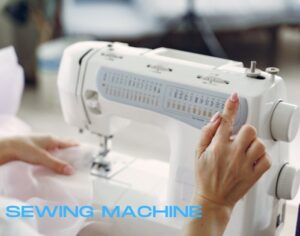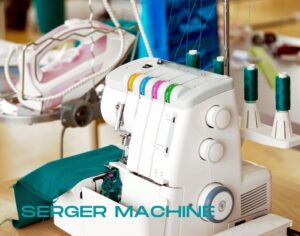As a beginner sewer, you may be wondering what kinds of machines you need to get started. The two main types of machines you’ll need are a sewing machine and a serger machine. A sewing machine is used to sew fabrics together, while a serger machine is used to finish the edges of fabrics. This blog post will discuss the differences between these two types of machines and what kinds of projects you can use them for.
What is a Sewing Machine?
 A sewing machine is a machine used to stitch pieces of fabric together. It is composed of a needle and thread that are fed through the fabric. The needle punctures the fabric, pulling the thread through and forming a stitch. The sewing machine is operated by a foot pedal that controls the needle.
A sewing machine is a machine used to stitch pieces of fabric together. It is composed of a needle and thread that are fed through the fabric. The needle punctures the fabric, pulling the thread through and forming a stitch. The sewing machine is operated by a foot pedal that controls the needle.
What is a Serger?
 A serger is a sewing machine to finish the edges of seams on the fabric. It can also be used to create decorative stitching on fabric. Sergers are often used in garment construction and quilting.
A serger is a sewing machine to finish the edges of seams on the fabric. It can also be used to create decorative stitching on fabric. Sergers are often used in garment construction and quilting.
Key Differences Between a Sewing Machine and a Serger Machine
Sewing machines and sergers are both used to sew fabrics together. The critical difference between a sewing machine and a serger is that a serger can sew fabrics together with an overlock stitch. An overlock stitch is a type of stitch that sews over the edge of the fabric to prevent it from unraveling.
A serger machine is a specialized sewing machine used to create finished seams that are strong and have a professional appearance. Sergers also can cut away the excess fabric from the seam allowance, which helps to create a neater and more finished look.
On the other hand, sewing machines are general-purpose machines that can be used for various projects. While a sewing machine can create solid and finished seams, it does not have the same ability to cut away the excess fabric.
A sewing machine sews straight stitches in the fabric, while a serger machine sews a clean finished edge.
When Should You Use a Serger?
Consider these guidelines if you’re unsure when to use a serger. A serger should be used:
- To finish raw edges on woven fabrics: When you cut fabric, the edges are usually raw and can fray easily. A serger sews over these edges and finishes them with a clean, professional look.
- To sew stretchy or knit fabrics: Knit fabrics can be challenging to sew without a serger because of their stretchiness. A serger helps keep the fabric out of shape as you sew. However, a serger may not be the best option if you are looking for a decorative seam.
- To create ruffles and gather fabric: A serger can quickly and easily gather the fabric to create ruffles.
- To sew curves: A serger can sew around curves smoothly without puckering the fabric.
- The type of fabric you are working with: Some fabrics, such as knit fabrics, benefit from using a serger. Others, such as woven fabrics, do not.
- The amount of time you have: Sergers are generally faster than sewing machines when creating seams. Suppose you are working on a deadline.
How Does the Serger Machine Work?
A Serger machine creates clean, professional-looking seams on garments and other textile projects. It does this using a special needle and thread fed through the machine at high speed. Then, the machine sews the fabric together using a series of tiny, tight stitches, which helps to prevent fraying and gives the finished product a much neater appearance.
The Benefits of Using a Serger Machine:
A serger machine can be a great asset in your sewing room. Sergers can make sewing projects go faster and give you professional-looking results. Here are some of the advantages of operating a serger machine:
1. Sergers can sew faster than a regular sewing machine.
2. Sergers can create a professional-looking finish on your sewing projects.
3. Sergers can help you save time on sewing projects.
4. Sergers can be an excellent investment for your sewing room.
5. Sergers can give you the ability to create professional-looking results at home.
The Drawbacks of Using a Serger Machine
A serger machine is a powerful tool to help you finish your sewing projects quickly and professionally. However, there are some drawbacks to using a serger machine.
First, they can be expensive.
Second, they can be challenging to use if you are unfamiliar.
Third, they can create a lot of noise.
Fourth, they can be messy.
Finally, they can be dangerous if you are not careful.
When Should You Use a Sewing Machine?
Here are a few general guidelines if you are unsure when to use a sewing machine.
- Sewing machines are typically used for fabric projects like clothing, home decor, or quilts.
- They can save you a lot of time by sewing multiple seams simultaneously.
- They can also sew straight seams more evenly than you can by hand.
- If you are working with a delicate or slippery fabric, a sewing machine can help you avoid accidentally tearing or stretching the fabric.
Of course, there are many other reasons to use a sewing machine.
How Does the Sewing Machine Work?
The sewing machine is a complex and fascinating tool. Its ability to quickly and easily stitch together fabric has made it an essential part of the modern world. But how does the sewing machine work?
At its most basic, the sewing machine comprises a needle and thread used to pierce and stitch together fabric. The needle is attached to a shaft driven by a motor, which causes it to move up and down rapidly. The thread is fed through the needle and attached to a moving shaft.
When the sewing machine is switched on, the needle and thread move. The needle penetrates the fabric, and the thread is fed through the needle. As the fabric is fed through the machine, the needle and thread stitch it together.
A sewing machine is a complex tool essential to the modern world.
The Benefits of Using a Sewing Machine
There are many benefits of using a sewing machine over hand sewing.
- Sewing machines are faster and can sew much more evenly than a person can.
- They are also great for sewing heavier fabrics, as they can apply more pressure than a person can.
- Additionally, sewing machines can create stitch patterns that would be very difficult to replicate by hand.
The Drawbacks of Using a Sewing Machine
Though sewing machines can be a huge time saver, there are some definite drawbacks to using one.
First, you can easily damage your fabric if you don’t know how to use a sewing machine properly.
Second, sewing machines can be very demanding; they can break down often if you don’t maintain them properly.
Finally, you can easily sew your fingers together if you’re not careful!
In Conclusion, consider picking up a sewing machine if you are doing a home project and need sewing. A sewing machine is a more specialized tool than a serger, requires less maintenance, and is less prone to breaking down. A sewing machine is less likely to require repairs than a serger, but if they do, they typically cost far less to repair than a serger.
